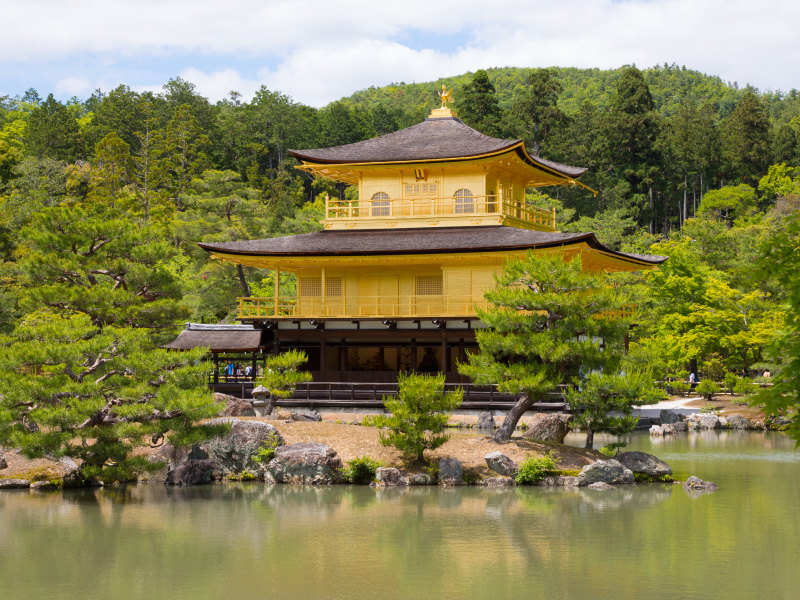
Kinkaku-ji (Rokuon-ji Temple) – The Golden Treasure of Kyoto
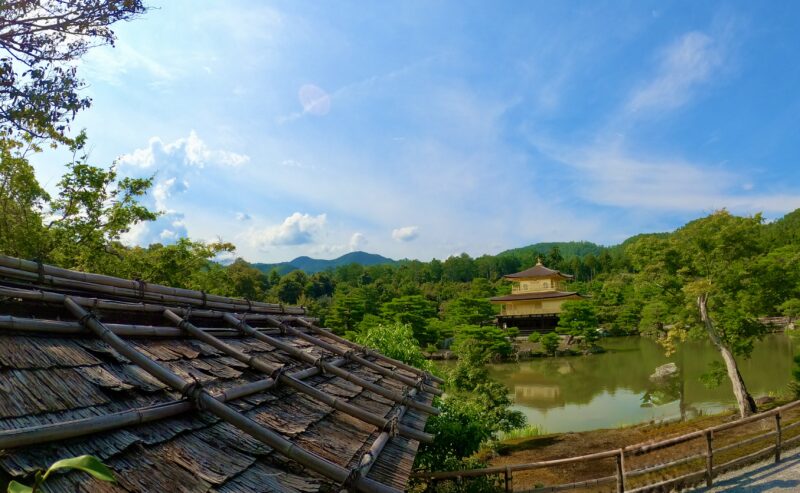
Located in the northern part of Kyoto City, Kinkaku-ji is a Zen temple of the Rinzai sect’s Shokoku-ji school. While its official name is Rokuon-ji, it is known worldwide as Kinkaku-ji (Temple of the Golden Pavilion) because of its iconic reliquary hall, the “Kinkaku,” which is famously covered in gold leaf. In 1994, it was registered as a UNESCO World Heritage site as one of the “Historic Monuments of Ancient Kyoto.”
金閣寺(鹿苑寺)― 黄金に輝く京の至宝
京都市北部に位置する金閣寺は、正式には「鹿苑寺(ろくおんじ)」と称する臨済宗相国寺派の寺院です。その象徴である舎利殿「金閣」があまりにも有名なため、「金閣寺」の名で世界中に知られています。1994年には「古都京都の文化財」の一つとして、ユネスコ世界遺産に登録されました。
History and Origins
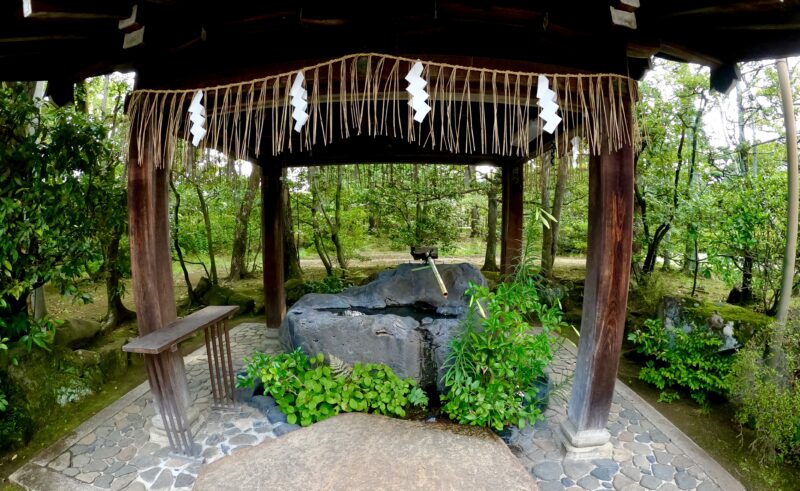
The history of Kinkaku-ji begins in the Kamakura period as a villa named “Kitayama-dai,” owned by a court nobleman, Saionji Kintsune. Later, the third shogun of the Muromachi shogunate, Ashikaga Yoshimitsu, acquired the property and built his magnificent villa, “Kitayama-dono,” centered around the pavilion.
At the time, Kitayama-dono was a vibrant center of politics and culture. It served as a grand setting for hosting the emperor and court nobles, and also functioned as a guesthouse to promote trade with Ming Dynasty China. The elegant culture that blossomed during this period is known as “Kitayama Culture.”
After Yoshimitsu’s death, and according to his will, the villa was converted into a Zen temple. It was named Rokuon-ji, derived from “Rokuon-in-dono,” the posthumous Buddhist name given to Yoshimitsu.
歴史と由緒
金閣寺の歴史は、鎌倉時代の公卿・西園寺公経(さいおんじきんつね)がこの地に営んだ別荘「北山第(きたやまだい)」に遡ります。その後、室町幕府の三代将軍・足利義満がこの地を譲り受け、舎利殿を中心とした壮大な「北山殿(きたやまどの)」を造営しました。当時の北山殿は、政治と文化の中心地であり、天皇や公家を招いての宴や、中国(明)との貿易を推し進める迎賓館としての役割も果たしていました。この時代に花開いた文化は「北山文化」として知られています。
義満の死後、彼の遺言に従ってこの地は禅寺とされ、義満の法号「鹿苑院殿(ろくおんいんでん)」にちなんで「鹿苑寺」と名付けられました。
Religious Sect
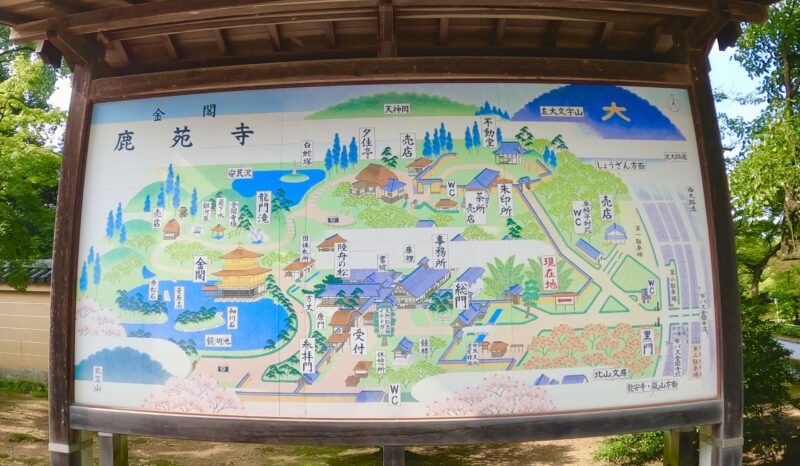
Kinkaku-ji belongs to the Shokoku-ji school of the Rinzai sect of Zen Buddhism.
The core teaching of the Rinzai sect is to follow the orthodox teachings of the Buddha. Through the practice of Zazen (seated meditation), followers engage in self-reflection to awaken to the pure human nature that is inherent in everyone.
宗派
金閣寺の宗派は「臨済宗相国寺派」です。 臨済宗は、お釈迦様の正しい教えを受け継ぎ、坐禅を組むことで自分自身と向き合い、本来誰もが持っている純粋な人間性を見つめ直すことを教えの根幹としています。
Admission Ticket and Official Pamphlet
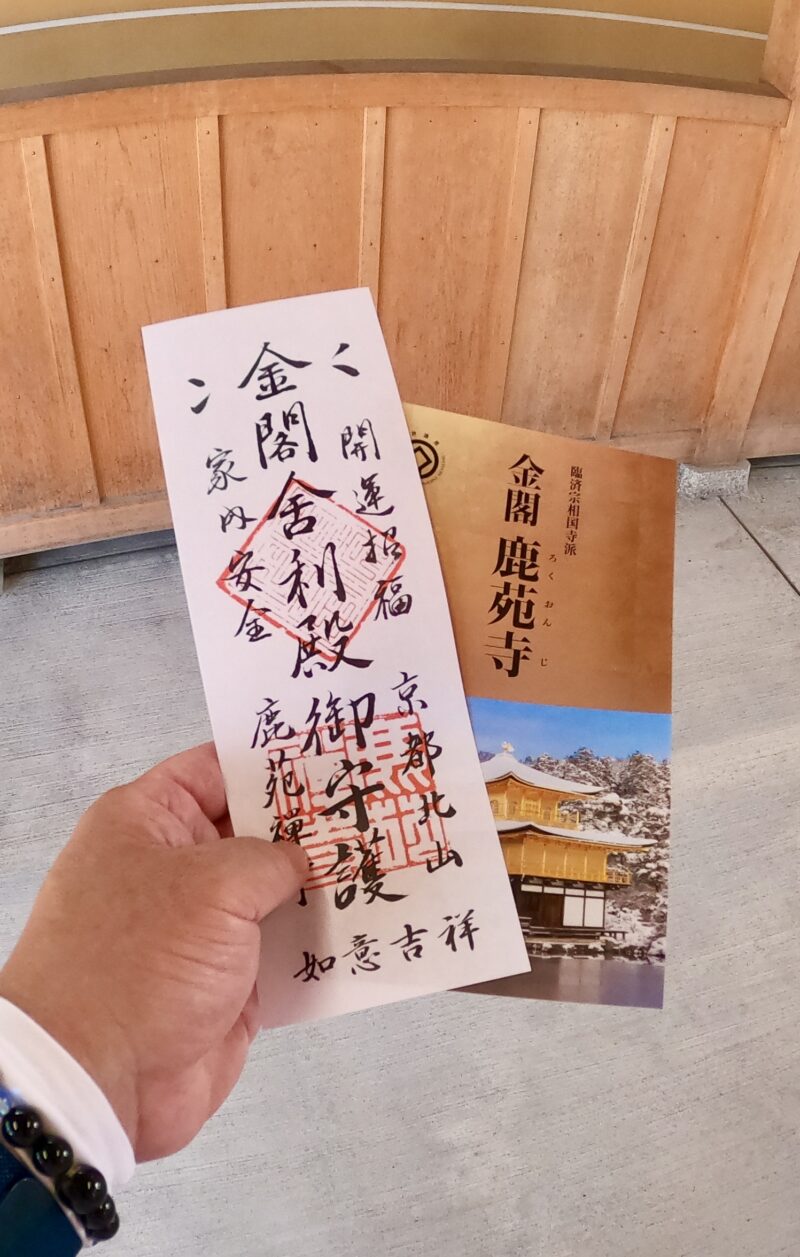
Instead of a conventional ticket, Kinkaku-ji Temple (Rokuon-ji) provides visitors with a unique admission pass in the form of a paper amulet, known as an “ofuda.” Inscribed with auspicious calligraphy such as “開運招福” (Kaiun Shōfuku – Bringing good luck and happiness) and “家内安全” (Kanai Anzen – Safety for the family), this special amulet serves as both your entry to the temple grounds and a protective charm to take home. It’s a wonderful memento of your visit, believed to bring blessings.
The image also features the official pamphlet, which contains information about the history of Kinkaku-ji and a guide to its grounds, given to visitors along with the admission amulet.
拝観券(入場券)と公式パンフレット
金閣寺(鹿苑寺)を訪れた際に受け取る拝観券は、一般的なチケットとは異なり、縁起の良い「お札(おふだ)」の形をしています。この特別なお札には、「開運招福(かいうんしょうふく)」や「家内安全(かないあんぜん)」といった幸運を願う言葉が墨書きされています。
この拝観券は、境内への入場を証明するだけでなく、持ち帰って家で大切に祀ることでお守りとしての役割も果たします。参拝の記念として、そのご利益を願うことができる、非常に特別なものです。
写真には、このお札の形の拝観券と、金閣寺の歴史や境内の情報が掲載された公式パンフレットが一緒に写っています。
Temple Grounds Information Board 【境内案内板】
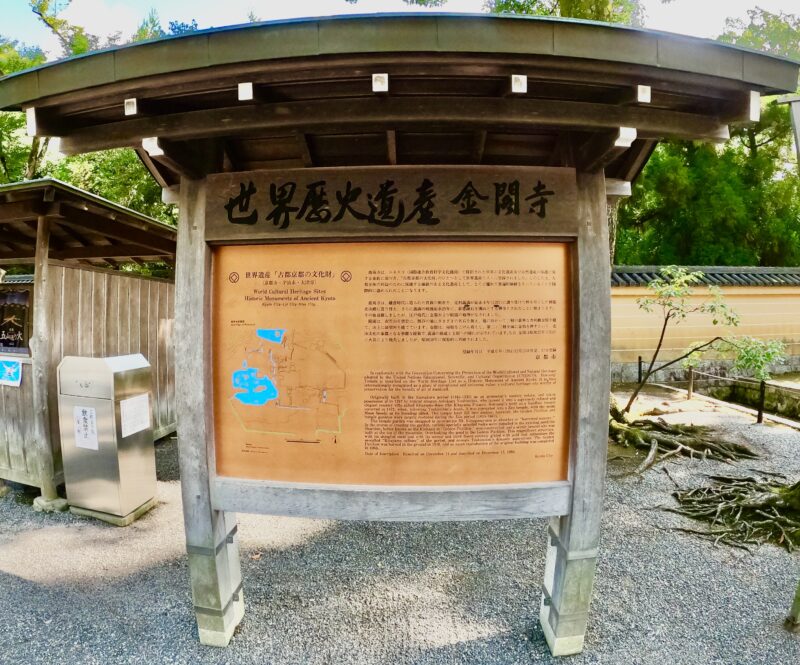
Located near the entrance to Kinkaku-ji Temple, this information board serves as the initial guide for visitors. The prominent inscription “世界遺産 金閣寺” (World Heritage Kinkaku-ji) signifies the temple’s esteemed historical and cultural importance.
At the center of the board is a detailed map of the temple grounds, allowing visitors to preview the recommended route and locate key attractions, with the Golden Pavilion as the focal point. Additionally, comprehensive explanations in both Japanese and English detail Kinkaku-ji’s registration as part of the UNESCO World Heritage site “Historic Monuments of Ancient Kyoto,” along with its rich history.
This information board offers invaluable context and guidance at the start of your exploration of the Kinkaku-ji Temple grounds.
境内案内板
金閣寺の入り口近くに設置された案内板です。大きく「世界遺産 金閣寺」と書かれた文字が、その歴史的価値と重要性を静かに物語ります。
案内板の中央には、金閣を中心とした境内全体の詳細な地図が描かれており、参拝者はこの地図で順路や見どころの位置を事前に把握することができます。また、日本語と英語で、金閣寺がユネスコ世界遺産「古都京都の文化財」として登録された背景や、その豊かな歴史について詳しい解説を読むことができます。
World Cultural Heritage Sites
Historic Monuments of Ancient Kyoto
(Kyoto City, Uji City, Otsu City)
In conformity with the Convention Concerning the Protection of the World Cultural and Natural Heritage adopted by the United Nations Educational, Scientific, and Cultural Organization (UNESCO), Rokuon-ji Temple is inscribed on the World Heritage List as a Historic Monument of Ancient Kyoto. It is thus internationally recognized as a place of exceptional and universal value; a cultural heritage site worthy of preservation for the benefit1 of all of mankind.
Originally built in the Kamakura period (1185-1332) as an aristocrat’s country estate, and taken possession of in 1397 by retired shogun Ashikaga Yoshimitsu, who turned it into a serenely refined and elegant mountain villa called Kitayama-dono (the Kitayama palace). Rokuon-ji’s birth as a Buddhist temple occurred in 1422, when, following Yoshimitsu’s death, it was converted into a Zen temple, with the monk Muso Soseki as its founding abbot. The temple buildings fell into ruin; however, the Golden Pavilion and temple gardens were largely reconstructed in the Edo period (1615-1867).
The temple gardens are designed to incorporate Mt. Kinugasayama as “shakkei,” or “borrowed scenery.” In the course of creating the garden, various specially selected rocks were installed in the existing pondlet. Shariden, better known as the Kinkaku or Golden Pavilion, was constructed, and a scenic inward view was built at the top of the mountain. Overlooking the pond is the Golden Pavilion. This magnificent structure, with its ground floor faced with bare wood and third floors (sic) entirely gilded with gold leaf, epitomizes the so-called “Kitayama culture” of the period, and reveals Yoshimitsu’s dynastic aspirations. The Golden Pavilion was burned to the ground in 1950, and an exact reproduction of the original building was completed in 1955.
Date of Inscription Resolved on December 15 and inscribed on December 17, 1994
Kyoto City
世界遺産「古都京都の文化財」
(京都市・宇治市・大津市)
鹿苑寺は、ユネスコ(国際連合教育科学文化機関)で採択された世界の文化遺産及び自然遺産の保護に関する条約に基づき、「古都京都の文化財」のひとつとして世界遺産リストに登録されました。このことは、人類全体の利益のために保護する価値のある文化遺産として、とくにすぐれた普遍的価値をもっていることを国際的に認められたことになります。
鹿苑寺は、鎌倉時代に造られた貴族の別荘を、足利義満が応永4年(1397)に譲り受けて粋を尽くした邸宅北山殿に造り替え、さらに義満の死後応永29年に、夢窓疎石を開山とする禅寺とされたことに始まります。その後衰微しましたが、江戸時代に金閣および庭園の修理がなされました。
庭園は、衣笠山を借景に、既存の池にさまざまな名石を据え、池に向って三層の豪華な舎利殿金閣を建て、山上に展望所を建てています。金閣は、初層をこけら葺とし、第二・三層全面に金箔を押すという、北山文化の象徴となる華麗な建築で、義満の権威と王朝への憧れが示されています。なお、金閣は昭和25年(1950)に火災により焼失しましたが、昭和30年に復元的に再建されました。
登録年月日 平成6年(1994)12月15日決定、17日登録
京都市
Gankasui【巌下水】
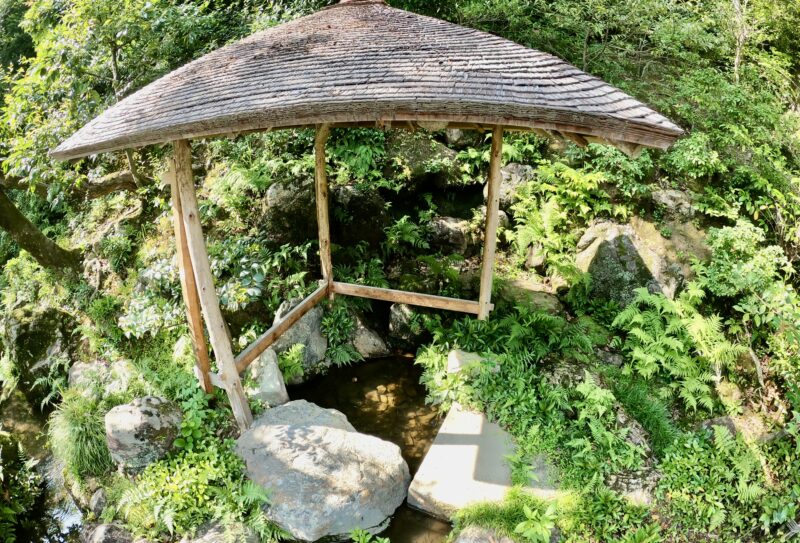
Gankasui is a natural spring found within the grounds of Kinkaku-ji. It is said that Ashikaga Yoshimitsu, the third shogun of the Muromachi shogunate, used the pure water from this spring for his personal tea ceremonies.
This historic spring has been carefully preserved, and its clear, fresh water continues to flow quietly to this day. The name “Gankasui” translates to “water from under the rock,” perfectly describing its origin. This spot offers a glimpse into the refined aesthetic and daily life of Yoshimitsu, who deeply appreciated the art of tea.
巌下水(がんかすい)は、金閣寺の境内にある天然の泉です。室町幕府三代将軍である足利義満が、この泉から湧き出る清らかな水を、自らのお茶会に用いたと伝えられています。
「巌(いわ)の下から湧き出る水」を意味するその名の通り、今もなお澄んだ水が静かに湧き続けています。この歴史ある泉は、お茶の文化を深く愛した義満の、洗練された美意識や暮らしぶりを垣間見ることができる貴重な場所です。
Gingasen【銀河泉】
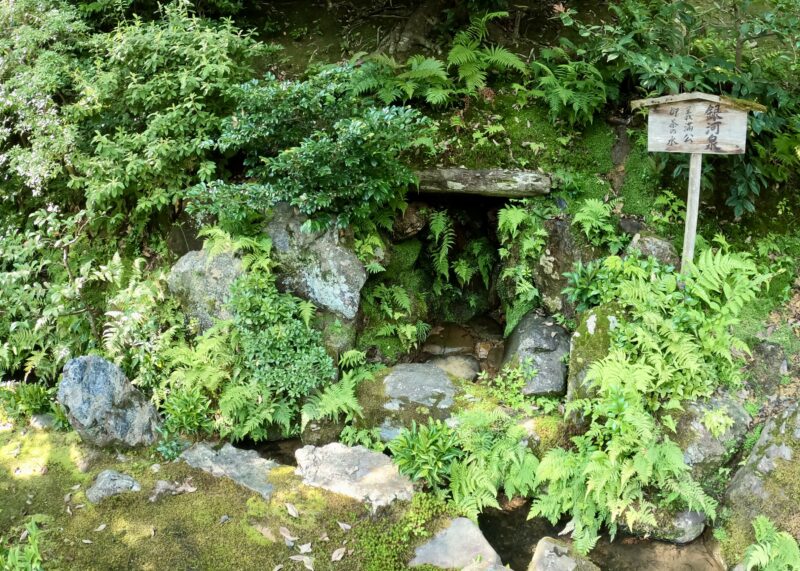
Gingasen, or “The Milky Way Spring,” is another of the famous springs located within the Kinkaku-ji gardens. It is said that the water from this spring, along with that from Gankasui, was used by the shogun Ashikaga Yoshimitsu for his tea ceremonies.
Set amongst lush moss and ferns, the spring flows quietly from the hillside, creating a beautifully serene and picturesque scene. The poetic name, “Milky Way,” evokes a sense of pristine beauty and adds to the tranquil atmosphere of the garden path.
銀河泉(ぎんがせん)は、巌下水と並んで金閣寺の庭園に存在する名泉です。この泉から湧き出る水も、足利義満がお茶の水として愛用したと伝えられています。
緑豊かな苔やシダに囲まれた岩間から静かに水が湧き出る様子は、非常に風情があり、訪れる人々の心を和ませます。「銀河」という美しい名前が付けられたこの泉は、庭園の散策路に清らかな趣を添えています。
Hakuja no Tsuka【白蛇の塚】
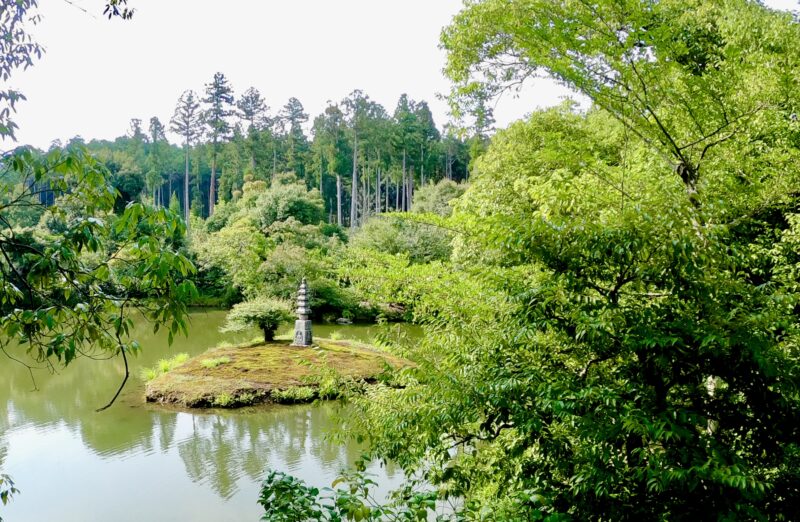
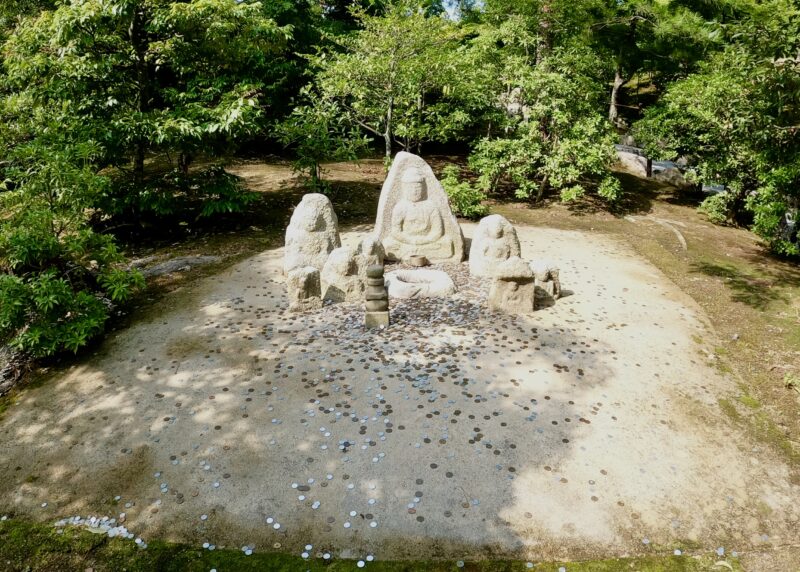
This five-storied stone pagoda, standing elegantly on a small island in Kyoko-chi Pond, is the Hakuja no Tsuka (Mound of the White Snake). According to legend, this mound is dedicated to a white snake that was the guardian deity of the Saionji family, the original owners of this land before it was acquired by the shogun Ashikaga Yoshimitsu.
As the white snake is also considered an envoy of Benzaiten, the goddess of wealth and fortune, this spot is a sacred symbol within the garden. Surrounded by the calm waters of the pond, the pagoda creates a serene and picturesque focal point in the landscape.
鏡湖池(きょうこち)に浮かぶ小島の上に建てられた、この五重石塔が「白蛇の塚(はくじゃのつか)」です。伝説によれば、この塚は、この土地の元々の所有者であった西園寺家の鎮守(守り神)であった白蛇を祀っていると伝えられています。
白蛇は財福を司る弁財天(べんざいてん)の使いともいわれることから、この場所は庭園における神聖な象徴となっています。静かな池の水面に囲まれたその姿は、庭園の風景の中に穏やかで絵画のような趣を加えています。
Fudo-do Hall【不動堂】
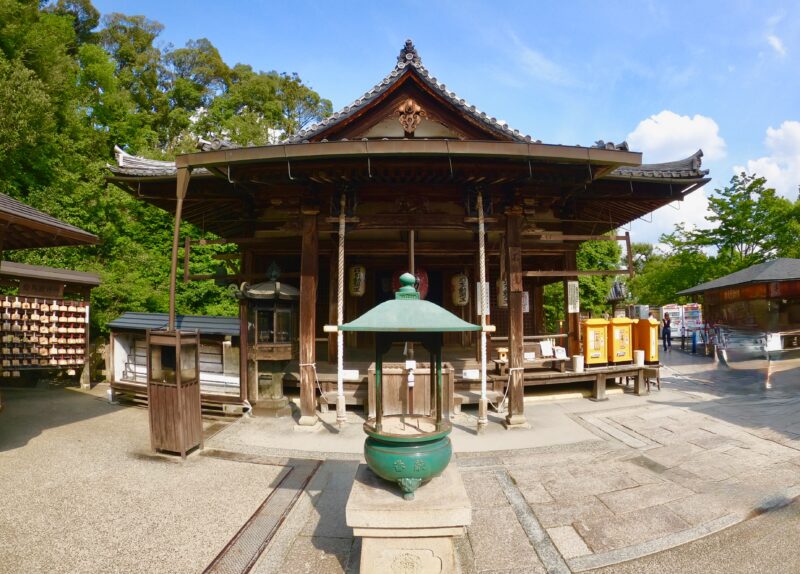
This building is the Fudo-do Hall, a place of active worship dedicated to Fudo Myo-o (Acala), one of the most important deities in Japanese Buddhism, known as a powerful protector of the faith.
Notably, the Fudo-do Hall is considered the oldest original structure still standing on the Kinkaku-ji grounds. The hall enshrines a stone statue of Fudo Myo-o, which, according to legend, was carved by the great monk Kobo Daishi (Kukai). Due to this sacred statue and its long history, the hall is revered as a significant “power spot” where visitors come to offer prayers for blessings and protection.
こちらの建物は、金閣寺の境内で信仰の中心となっている「不動堂(ふどうどう)」です。堂内には、厄災を除き人々を守護する力強い仏様である不動明王(ふどうみょうおう)が祀られています。
この不動堂は、金閣寺の敷地に現存する最も古い建物といわれています。ご本尊である石造りの不動明王像は、弘法大師(空海)の作と伝えられており、古くから霊験あらたかなパワースポットとして多くの人々の信仰を集めてきました。節分などの行事もここで行われ、今日でも多くの参拝者が祈りを捧げる場所となっています。
Kinkakuji-gaki Fence and Kokeikyo Bridge【金閣寺垣と虎渓橋】
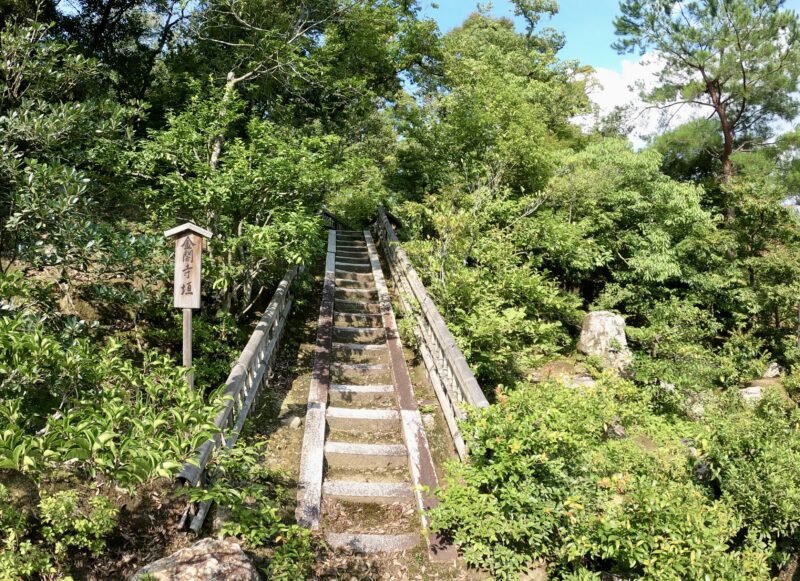
A stone staircase, flanked by the distinctive “Kinkakuji-gaki” (a style of low bamboo fence named after this temple), leads towards the “Kokeikyo” (Tiger Valley Bridge). Visitors cross this path to reach the Sekka-tei Teahouse.
The Kinkakuji-gaki fence is renowned for its simple and elegant beauty and has become a famous style used in traditional Japanese gardens throughout the country. The name of the bridge, Kokeikyo, is derived from a well-known Zen parable. Crossing it symbolically represents leaving the secular world behind to enter a more sacred and serene space.
金閣寺垣(きんかくじがき)と呼ばれる特徴的な竹垣が両脇に続く石段は、その先にある虎渓橋(こけいきょう)へと至る道のりです。この橋を渡ると、茶室「夕佳亭」へと向かいます。
金閣寺垣は、そのシンプルで洗練された美しさから、この寺院の名を冠する有名な様式として全国の日本庭園で用いられています。また、虎渓橋という名は禅の故事に由来しており、この橋を渡ることは、俗世を離れて神聖な領域へ足を踏み入れることを象徴しています。
Ryūmon-taki Waterfall and Rigyoseki Stone【龍門滝と鯉魚石】
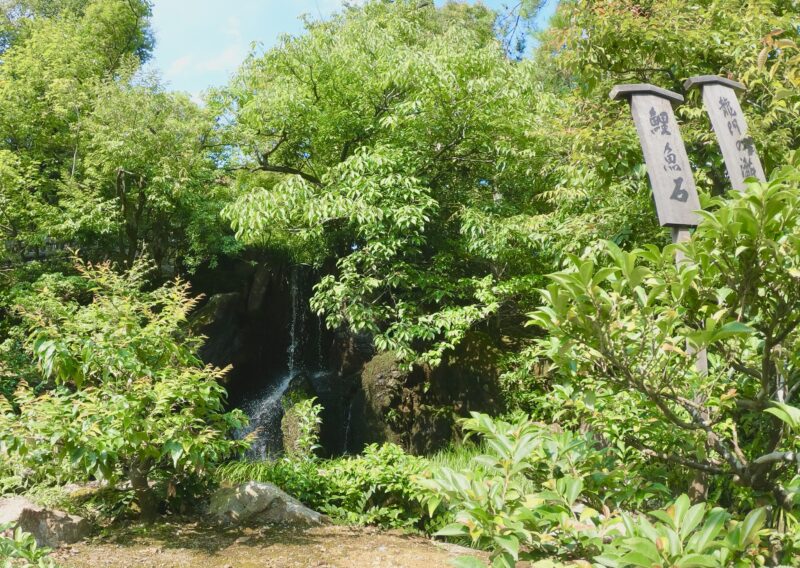
This dynamic waterfall, known as “Ryūmon-taki” (Dragon Gate Waterfall), and the stone placed in its basin, the “Rigyoseki” (Carp Stone), work together to depict a powerful legend. This arrangement is based on a famous Chinese tale where a carp that successfully swims up the fierce Dragon Gate Waterfall transforms into a mighty dragon.
This story is a well-known metaphor in East Asia for overcoming great obstacles to achieve success. In this garden scene, the Rigyoseki stone represents the carp gathering its strength for the arduous leap. The constant flow of water over the rocks imbues the tranquil garden with a sense of energy and perseverance, offering encouragement to all who view it.
こちらの滝は「龍門滝(りゅうもんのたき)」、そして滝壺に置かれた石は「鯉魚石(りぎょせき)」と呼ばれ、有名な故事を表現した庭園の設えです。これは「激しい流れの龍門の滝を鯉が登りきると、龍になる」という中国の伝説に基づいています。
この故事は、人生における難関を突破して成功を収めることのたとえ「登龍門」の語源ともなっています。鯉魚石は、まさに今、龍門の滝を登ろうとする鯉の姿を現しており、その力強い姿は見る者に勇気を与えてくれます。静かな庭園の中で、水が流れ落ちる音と動きが、生命力あふれる空間を創り出しています。
Shariden Kinkaku – The Golden Pavilion【舎利殿金閣】
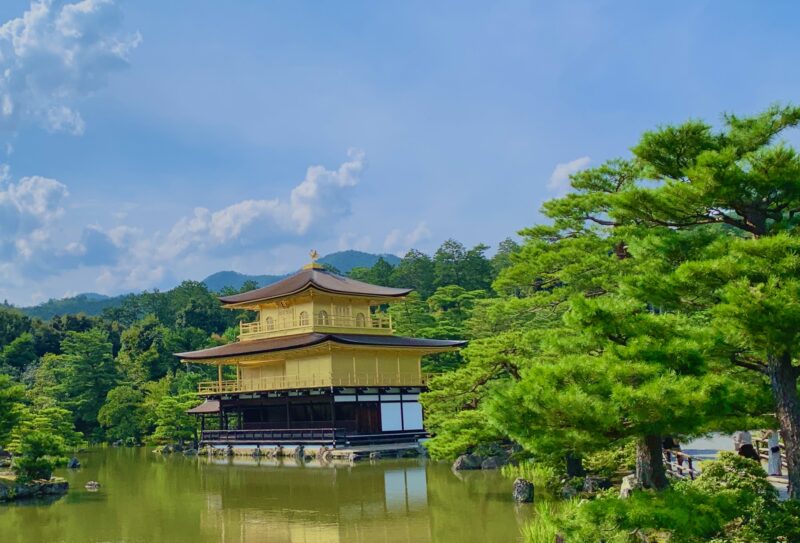
The Shariden, famously known as the Kinkaku or Golden Pavilion, is the breathtaking centerpiece of the Rokuon-ji temple complex. Set against the calm waters of the Kyoko-chi (Mirror Pond), the top two floors of this three-story pavilion are covered in brilliant gold leaf, creating a stunning reflection that has captivated visitors for centuries.
Each of the three floors is built in a different architectural style—the first floor in the style of an aristocratic palace, the second like a samurai residence, and the third in a traditional Zen temple style. This unique combination reflects the culture of the era when it was built by the shogun Ashikaga Yoshimitsu. Crowning the roof is a radiant golden phoenix, a mythical bird symbolizing good fortune. The entire structure, perfectly harmonized with its garden and pond, is designed to represent the Buddhist Pure Land paradise on Earth.
鹿苑寺の象徴であり、息をのむほどに美しい建物が、この舎利殿(しゃりでん)、通称「金閣」です。鏡湖池(きょうこち)のほとりに佇み、二層と三層が豪華な金箔で覆われたその姿は、水面に美しい「逆さ金閣」を映し出し、訪れる人々を魅了してやみません。
この三層の楼閣は、一層が公家風の寝殿造、二層が武家造、三層が禅宗様の仏殿造と、各層が異なる様式で建てられています。これは、この建物を造営した将軍・足利義満の時代の文化を反映した独創的な建築です。屋根の頂には、吉祥の象徴である金色の鳳凰が輝いています。庭園や池と完璧に調和したその姿は、仏教の説く極楽浄土をこの世に現したものとされています。
Sekka-tei Teahouse【夕佳亭】
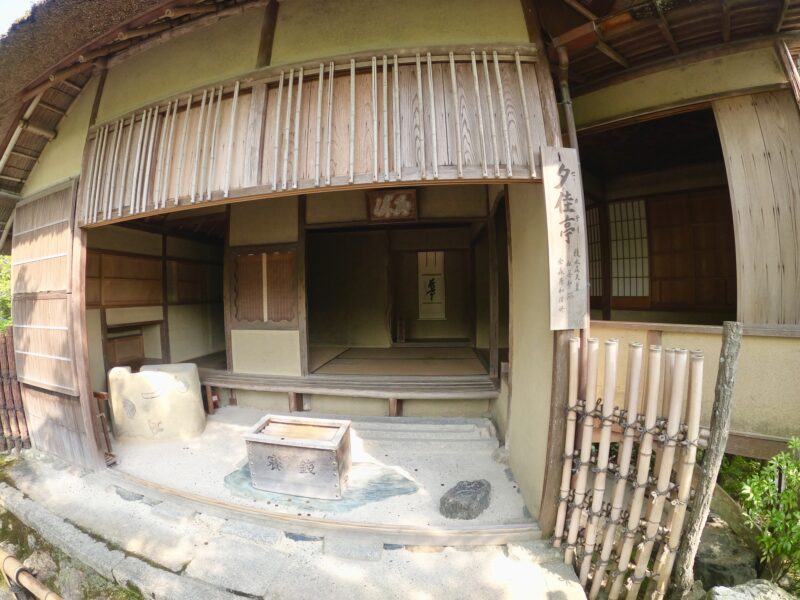
Located on a small hill within the garden is the Sekka-tei, a traditional teahouse with a rustic thatched roof. The name “Sekka-tei” translates to “Evening Beauty Pavilion,” and it is said to have been named so because the view of the Golden Pavilion, bathed in the glow of the setting sun, is exceptionally beautiful from this vantage point.
Originally built in the Edo period by the tea master Kanamori Sōwa, this teahouse embodies the spirit of wabi-sabi—an aesthetic of rustic simplicity and harmony with nature. This stands in beautiful contrast to the golden splendor of the main pavilion. The teahouse is also famed for its unique alcove post made from a naturally shaped Nandina tree, a feature highly prized in the world of the tea ceremony.
庭園内の小高い場所に建つ、茅葺き屋根の趣ある建物が茶室「夕佳亭(せっかてい)」です。「夕日に映える金閣がことさらに佳(よ)い」ということから、この名が付けられたといわれています。その名の通り、ここから眺める夕暮れ時の金閣は格別の美しさです。
江戸時代に茶道家の金森宗和(かなもりそうわ)によって造営されたこの茶室は、華やかな金閣とは対照的に、簡素で自然と調和した「わびさび」の精神を体現しています。特に、床の間に用いられた天然木の「南天の床柱(なんてんのとこばしら)」は有名で、茶室建築の粋を集めた名席として知られています。
Fuji-gata Chōzubachi / Fuji-shaped Hand-washing Basin【富士形手洗鉢】
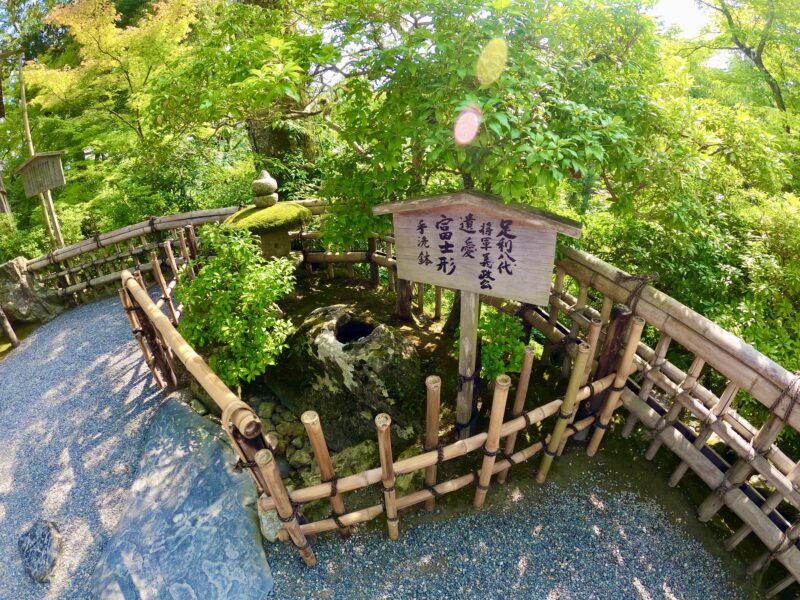
This stone water basin, known as the “Fuji-gata Chōzubachi” (Fuji-shaped Hand-washing Basin), is a prized historical artifact within the Kinkaku-ji gardens. According to the signpost, this basin was a beloved personal possession of Ashikaga Yoshimasa, the 8th shogun of the Muromachi shogunate.
Shogun Yoshimasa is renowned as the founder of Ginkaku-ji (the Silver Pavilion) and a great patron of the Higashiyama Culture, which deeply influenced the development of the Japanese tea ceremony. A chōzubachi like this one is traditionally used for ritual purification before entering a teahouse. Its connection to a famous historical figure makes it a particularly valuable treasure, embodying the spirit of wabi-sabi cherished in the tea ceremony.
こちらの石造りの手水鉢(ちょうずばち)は、「富士形手洗鉢(ふじがたちょうずばち)」と呼ばれ、室町幕府八代将軍・足利義政が愛用したと伝えられる貴重なものです。
足利義政は、銀閣寺を建立し、茶の湯をはじめとする東山文化を育んだ人物として知られています。茶室に入る前に手や口を清めるために使われる手水鉢は、茶庭に欠かせない要素です。特にこの手水鉢は、歴史的な人物が実際に愛用したという由緒を持ち、その自然で素朴な佇まいが、わびさびの精神を今に伝えています。


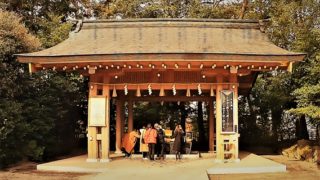

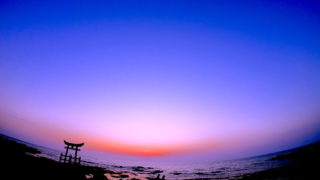


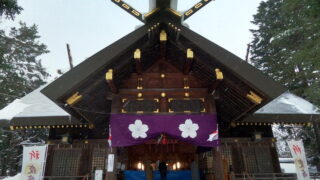
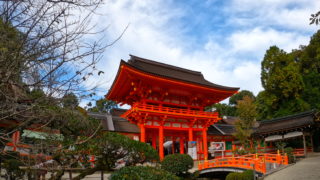
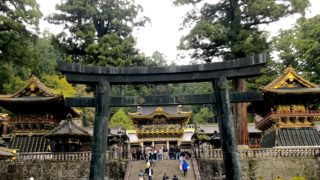

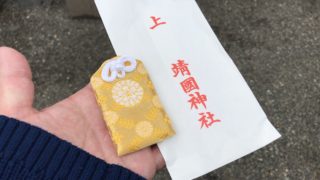

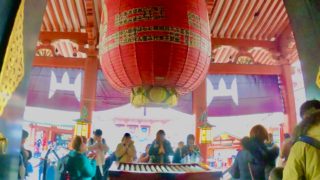
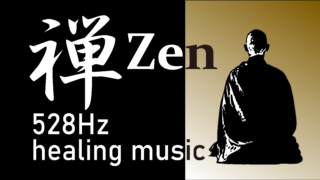

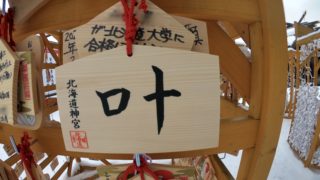
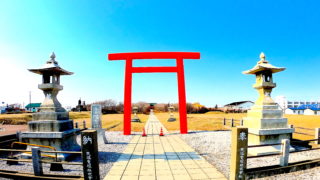
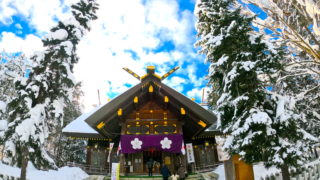
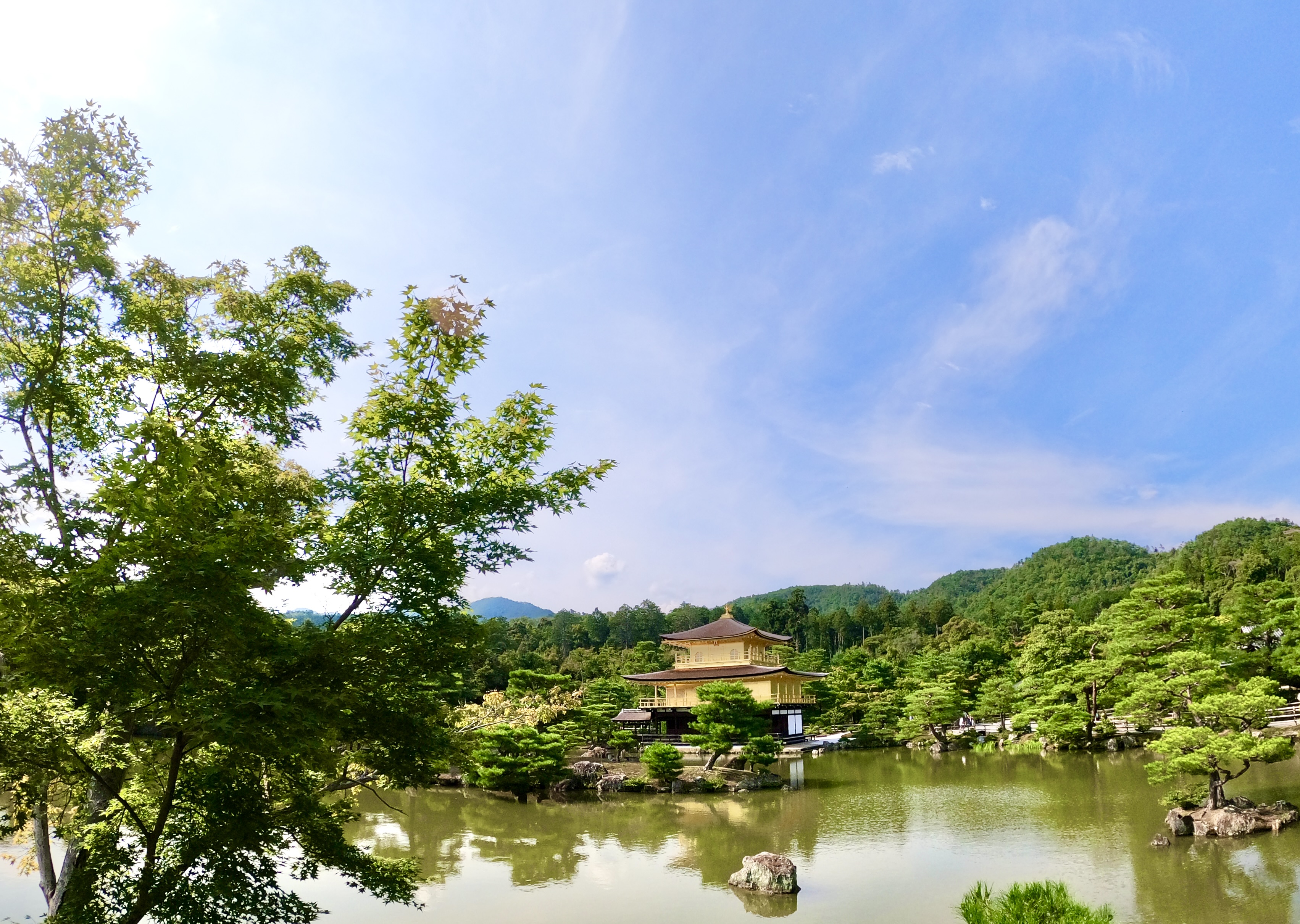



コメント